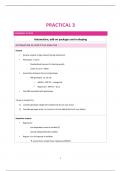Summary
Summary Solution practical 3 to 5 - data mining
- Course
- Institution
Complete solution (and assignment) of practicum 3 to 5 in English. Also a summary of the accompanying ppt. Includes codes and screenshots of the solutions in R. Everything is very quick and easy to find and clearly divided into the various practicals. This is the part that comes to the final exam...
[Show more]



